
Coppa or Capicola is an abbreviation of the Italian Capocollo, which in turn comes from the Latin “caput collum” and means neck, as pork neck meat is traditionally used to make this charcuterie delicacy. It can also be made with pork loin, which has much less fat than the neck.It is not difficult to make capicola at home, but it is laborious as it takes a lot of time and you need to understand the processes involved to be sure of what is being done. At first, the ideal is to follow the recipe exactly, but with experience you can change it according to your preferences. Always keep everything well sanitized.
In this capicola I tested the use of collagen film, which is a versatile and practical wrapper that can be applied to meat of any thickness. In addition to the canopy, it can also be used in other products that will undergo a long maturation process.

Capicola ingredients and processes
Capicola cure
- Pork neck – 826g;
- Salt – 2% – 17g;
- Curing salt 2 (6% of nitrite, 3% of nitrate and 93.75% of salt) – 0.25% – 2g;
- Antioxidant (with sodium erythorbate) – 0.25% – 2g (optional);
- Sugar – 5g – 0.5%.
The curing process is the beginning of production, it is the moment of salting and distribution of the curing salt, which is sodium nitrite and sodium nitrate, to understand better about curing salt go to Curing salt. The antioxidant is optional but aids in the healing process and helps prevent lipid oxidation or fat rancidity.
Cut the piece of meat into 10 cm segments to make it easier to handle and store the finished product. When purchasing a piece of overcoat, it may include part of the rib bones and a little of the loin. Remove all the bone. The loin can be used as it is difficult to identify and separate perfectly from the piece.
Apply the salt, curing salt and antioxidant to the meat, massaging well to spread and distribute evenly. Place the piece in a container with a lid or in a tightly closed plastic bag and leave it in the refrigerator for 15 days.

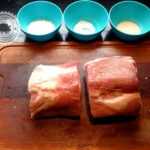
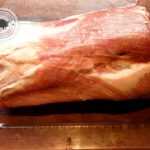
Capicola seasoning
- Brown sugar – 10g;
- Black pepper – 1g;
- Nutmeg – 1g;
- allspice 2g;
- Smoked paprika – 2g;
- Clove powder – 0.5g;
- Starter Culture (lactic acid bacteria) 0.1g – diluted in half a glass of water.
After the initial curing period, remove the item from the refrigerator, rinse it quickly and dry it with a kitchen towel or paper towel. Dilute the stater culture in water and spray or spread it with your hands over the piece. Prepare a mixture with the dry seasoning ingredients and apply by massaging well into the meat for complete distribution.
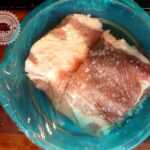
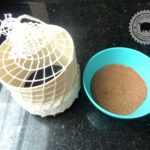
Casing and maturation
collagen film
Elastic net 50mm or 65mm – 15cm
After seasoning the piece, wrap it in the collagen film and apply the starter culture again to ensure its distribution. Wrap it in an elastic net to press and facilitate handling, tie the two ends and use an improvised hook or clips to hang the piece in a dark environment, with a mild temperature, around 14 degrees and high humidity, between 70% and 80%. In my case, I used a wine cellar with temperature control and a pot filled with water at the bottom to maintain humidity.

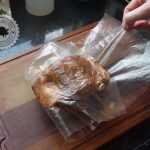
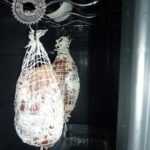
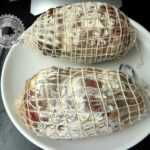
The Capicola will be ready when it loses between 30% and 40% of its initial weight. If you want a softer and smoother product, only let it lose 30%, if you want a firmer Capicola with a stronger flavor, leave it until it loses 40%.
During the COPA I lost weight as follows:
27/09 – 826g – 100% – starting weight
08/10 – 655g – 79%
10/29 – 534g – 64% – loss of 36% of initial weight
Final result
The product was excellent, with just the right amount of salt and very tasty, but not too spicy. I prefer to feel the flavor of the meat, so I don't apply too much seasoning, I prefer a product that resembles raw ham rather than the flavor of spices or pepper.
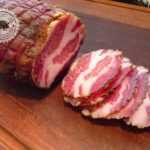
-
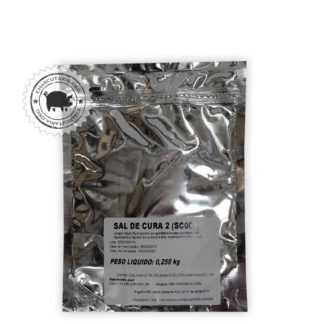 Curing salt 2R$ 8,00
Curing salt 2R$ 8,00 -
 Curing salt 1R$ 8,00
Curing salt 1R$ 8,00 -
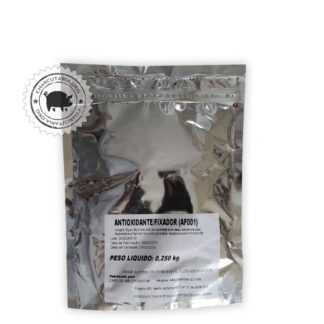 Fixative AntioxidantR$ 23,00
Fixative AntioxidantR$ 23,00 -
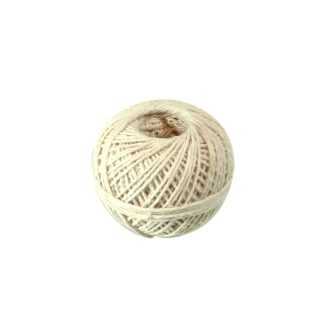 Culinary twineR$ 7,90
Culinary twineR$ 7,90 -
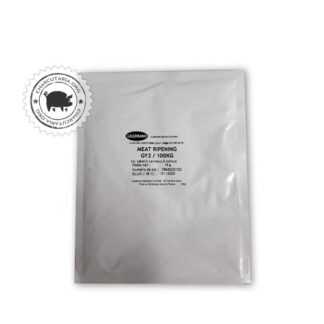 Starter CultureR$ 69,90
Starter CultureR$ 69,90 -
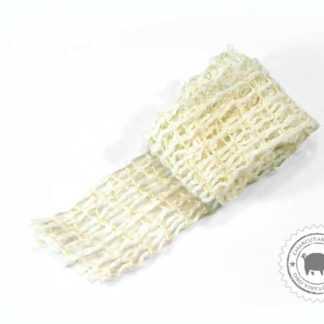 Culinary elastic net 50mmR$ 15,00
Culinary elastic net 50mmR$ 15,00 -
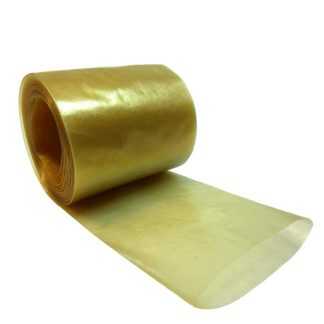 Collagen casing 45mm roll 5 meters salamiR$ 19,00
Collagen casing 45mm roll 5 meters salamiR$ 19,00 -
 Culinary elastic net 65mmR$ 18,00
Culinary elastic net 65mmR$ 18,00 -
 Collagen casing 80mm cup and salamiOriginal price was: R$ 39,00.R$ 29,90Current price is: R$ 29,90.
Collagen casing 80mm cup and salamiOriginal price was: R$ 39,00.R$ 29,90Current price is: R$ 29,90. -
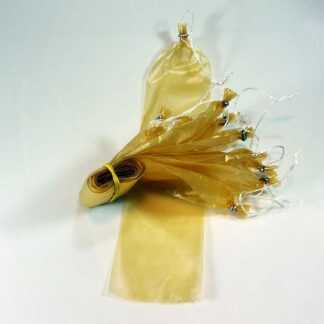 Salami collagen casing 45mm 10 units tiedR$ 19,00
Salami collagen casing 45mm 10 units tiedR$ 19,00 -
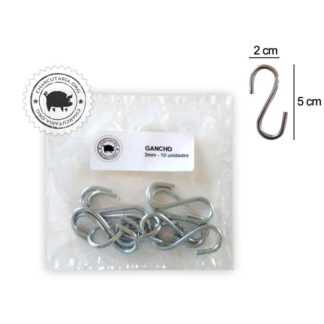 Galvanized HookR$ 12,00
Galvanized HookR$ 12,00 -
 Natural pork casing for sausageR$ 52,00
Natural pork casing for sausageR$ 52,00

Good afternoon.
A doubt. Do you place the ventilation (PC cooler) inside the wine cellar or if using a wine cellar is it not necessary?
The wine cellar in the video already has integrated ventilation to circulate cold air, so there was no need for an extra cooler.
I used Cultura starter and also Mold 600.
Remove these tops from the highest fermentation temperature, wash them well by scrubbing in water with a little salt, then apply the mold culture again and take them to the refrigerated chamber. Fermentation will also occur in the chamber, but more slowly.
Can I keep the film and net?
I took it to larvate and saw that it created air under the film.
I don't know if it could be the problem, but I made several holes in the film to remove all the air.
Do you know what could have happened?
I wanted to know so it doesn't happen with salami when I make it.
Some contamination may have occurred and the air was created by the fermentation of unwanted bacteria. In this case, the ideal is to remove the film and net, wash and re-wrap. I recommend that you do not fire the collagen. Try to wrap it by squeezing it to remove air and don't make holes. The gut is already designed to lose weight correctly, there is no need to pierce it, just if you see air bubbles.
Thank you very much!
Good afternoon, I have some doubts regarding this.
How would I know if unwanted bacteria are present in the final product? And can they harm me when consumed?
And is there any danger of this piece contaminating the other good ones in the chamber?
And thank you very much for your support.
Marcio, good afternoon. Only with laboratory analysis is it possible to know which bacteria are present. Protection barriers are applied to minimize the possibility of contamination, such as acidification due to the addition of an acidulant (wine, citric acid, etc.) or from fermentation, addition of salt, low temperature during maturation and loss of moisture, in addition to care in handling throughout the process and the acquisition of certified meat. There is always the possibility of one product contaminating another. By applying all protective barriers and following good practices, the chance of contamination is very low. If in doubt, discard the part and try to identify the source of contamination so that the same problem does not occur in the next production. Meat is a fresh, natural product, which has natural microbiology present.
Some I put in the chamber at 13C and they don't have that smell, it even smells like foot odor.
Hello, I made this recipe exactly as in the video.
Today it has been fermenting for a day, the problem is that it has a very bad smell of vinegar, very sour. What can it be?
Hi Marcio. Did you use the starter culture?
Yes, I used it.
Good afternoon, sorry for so many questions.
But I made this cup and 11 days ago it was ripening, 14ºc humidity was +-70%. She lost 30% in weight but the cover is not very hard and the inside is very soft, what could have happened?
Is there a way to fix it?
Note: Now I placed a humidifier where the humidity is between 70 and 80%.
Hi Marcio, I think everything is correct, at first the weight loss is faster, then it reduces. Keep the humidity high until the canopy loses at least 45% of its weight. Then check if it still appears soft in the center.
Eduardo would like to know about the seasoning. I see some recipes where some add the condiments in the first stage during curing, some add them during maturation and some add them before and after. What are the differences and what is the best way to do it?
Hi Andriel. In my point of view, the ideal is to place it in the first stage during curing and then, optionally, place it in the second stage during maturation. Seasoning in the second step is optional to add an extra layer of external seasoning, which enhances the flavor and creates an additional appearance. But there are different recipes and production traditions, there is no one more correct than the other, just the option that best suits the product you want to make.
Eduardo, I had a lot of difficulty wrapping the cups… I did the whole process and they've been in the cellar for about two weeks. However, I started to think that they have a strong smell and looking at other people's comments, I saw that there is some mold that might not be good. I am now observing that it has even formed underneath the collagen. I opened it to see, one has a normal smell, I think, but with white mold, the other has a piece that has a very strange smell... can I wash it with the vinegar and salt water solution and repackage it or should I discard it?
Hi Luciana, you can wash it well and return it to the cellar, if possible reduce the temperature a little. Keep following. I believe it will work. If you can, post photos to make it easier to analyze. Positive mold is always white and smooth/thin, it does not have filaments or different colors. Did you use the tubular casing? The collagen film/sheet is generally much easier as it does not depend on the thickness of the meat.
Good afternoon Eduardo,
After fifteen days in the fridge, can I do the rest of the canopy process at room temperature with plenty of ventilation?
Good evening Eduardo,
Can I use liquid smoke in the pantry? If yes, at what stage should I apply?
Hi Lucas. Right at the beginning, in the initial curing and seasoning stage that remains in the refrigerator. Apply the smoke along with the other seasonings and curing salt.
Thanks. I'm going to do this test.
Good morning Eduardo! Asking is not offensive!1) Curing stage: after carrying out the curing procedure, can I place the vacuum-packed meat in the refrigerator for 15 days?; 2) Maturation stage: after the maturation procedure, can I use the starter culture and vacuum pack the meat so that it can be dehydrated in the refrigerator? Are there any advantages/disadvantages to vacuum packaging? If using beef, can I use both crops in the same way as if it were pork? What is the role/effect of wine in the maturation procedure phase? Thanks!
Hi Sebastian.
In a vacuum, the meat will not dehydrate and the culture is aerobic, it needs oxygen to proliferate. So the fermentation, maturation and dehydration steps must be carried out outside the vacuum.
Regarding beef, you can apply both cultures as is done using pork.
Wine has flavor and protective action through acidification.
Good afternoon Eduardo, how are you?
I'm making the cup, according to the video above.
I left it in the fridge for 15 days, then put it on the collagen sheet with the seasonings and applied the starter culture before and after putting it on the collagen. Then it went to the fermentation process in the cellar, at 25 degrees and a humidifier turned on directly (as there was no humidity controller). It started to give off a very strong smell, even so I kept it fermenting for 3 days. As suggested by you, I took it out of the cellar and washed the piece with a solution of water, vinegar and salt and went through the maturation process, however the smell still persists and today is the 3rd day of maturation. What could have happened to give you that bad smell? Do you suggest that I discard the cups or continue with the process?
One more question about the process, in the description of the process above, fermentation for 3 days at a temperature of 24 degrees was not carried out. What's the difference if you then put it in the collagen and it goes straight to maturation and doesn't ferment?
These 3 days at high temperature serve to increase the proliferation rate of the starter culture, acidifying and protecting the product at the beginning of the process. This is the recommendation for using cultures, but sometimes I skip this step and go straight to the refrigerated environment, especially when the environment is very hot. When placed directly in a refrigerated environment, the culture's proliferation rate will be slower, consequently it will take longer for the culture to take effect. The amount of sugar in the recipe is also a fermentation controller, the more sugar, the more food for the culture to proliferate and acidify the product.
Hi Douglas. The process is correct, perhaps some cross-contamination during handling, but as it is still in its infancy, I recommend that you remove the collagen cup, wash the meat well, rub it with this solution of water, salt and vinegar, wrap it again and return it to the maturation in a refrigerated environment. Follow it for a few more days and see if the smell reduces or disappears.
Eduardo good afternoon. I'm preparing to season the cup (I've already gone through the salting process in the fridge for 15 days). The products I purchased from you have arrived and I have starter culture and fungal culture. I have doubts about how to use one and use another. Can you help me with this? Do I apply the starter culture to the piece and after wrapping it in collagen, do I use the fungal culture?
Thank you in advance for your attention.
Ricardo
Hi Ricardo, that's exactly what you mentioned. Apply the starter culture directly to the meat before wrapping. Apply the fungal culture after wrapping, to the outside of the canopy and, if desired, to the walls of the maturation environment. The more the fungus is spread throughout the region, the better.
Where can I buy collagen film in Portugal? Thanks
Good afternoon.
Since I make cheese at home, I want to take advantage of it and make some. To this end, based on the information on the website, I put together a recipe but before placing the order I would like to ask a few questions. I clarify that at first I will do one cup at a time.
1. For the World Cup, which Starter Culture is most suitable?
2. For the canopy, which Fungal Culture is most suitable?
3. Does Rosemary Natural Essence Antioxidant replace one of the two items above or does it have an independent function?
Thank you in advance for the clarifications.
Luiz Carlos
Hi Luiz.
1) I recommend that you use a bacterial starter culture with multiple action, that is, that it performs the basic protective fermentation but also adds other benefits such as flavor, aroma and color.
2) you can use the fungal culture penicillium nalgiovense, salamii or candidum (which is also used in cheeses).
3) the antioxidant in rosemary has a distinct function from that of other crops. The antioxidant will inhibit lipid oxidation (rancidity).
Hello Eduardo, how are you? Thank you very much for your latest support.
I removed the Cup with 35% +/- and it was very tasty. I have doubts about a white spot, apparently fungus, that has formed around it. I only used the start culture, so this shouldn't appear, right? Another thing, after removing the collagen, does the healing process stop? If not, how can I preserve it with less loss? Just storing it in the fridge will do the trick? Thank you very much!
Abs
Hi Ernesto. The cup looks great. Congratulations! The white and smooth fungus (fine powder type) is considered safe in delicatessen. If you still have doubts about whether it is safe to consume, wash the top well and cut off a small layer of the areas affected by the fungus. Then, to store, apply a little olive oil to the outside, wrap with two turns of PVC film and store in the refrigerator. It will last between 60 and 90 days.
Dear all, how are you?
A doubt! I prepared two pieces of filet mignon, added coarse salt, 2 curing salt, packaged both separately in plastic packaging, without air and left them in the refrigerator for 9 days; I removed it, washed it well, mixed the seasonings with a little wine and spread the paste on both; I sprayed the start culture on both and packed it as follows: 1 packed with collagen casing, tied it up, sprayed it again and hung it in my cellar at 16/17º and 70% humidity! The second one, I applied the seasoning, sprinkled the culture, wrapped it in baking paper 6 times and put it in the cellar, too!
I haven't opened the piece, which is in good parchment paper, but I know it's losing weight, around 20 % since last Friday! The other, in collagen casing, I don't notice the development of fungi, is this normal? She has already lost more than 25% since Friday, am I missing something? Even if there is no fungus, is there a chance it will get better? Thank you so much for your precious help!!
Yours sincerely
Ernesto
Hi Ernesto. How long have you been losing weight? The bacterial starter culture has direct action on the meat to promote color, flavor, aroma and protection, but has no action on the formation of external white fungus, which is promoted by another culture, which is mold/fungal culture. These two cultures are complementary and optional, and are not mandatory.
When mold/mildew culture is not applied, it is a positive point that external mold does not appear as it means that the process is running well without contamination by unknown fungi. Intentional white fungus (through the application of mold culture) is optional and any other fungus that appears must be removed as soon as possible by scrubbing water with salt and vinegar. Therefore, you can proceed normally and everything is going well!
If you have any additional questions, just ask!
Eduardo, good morning!
I'm doing the cup. I'm on the twentieth day and I'm already at 83% of my starting weight.
The cup is free of fungi, but it has a very strong odor and the exterior of the collagen is very sticky. Is this normal? Should I wash under running water to remove the slime and reduce the odor?
Thank you very much in advance.
Hi Juliano, a smell may come out due to fermentation or fungi. Fermentation of starter culture or other bacteria in the environment. Yes, you can clean it, rinse it under running water, rub gently to remove possible external contamination and then apply (spray or rub) a solution of water (200ml), salt (20g) and vinegar (1 tablespoon) before hanging again to help protect. Hugs!
Goodnight! I'm watching your videos to make the cup, I'm going to buy the products here but I had a question when reading the comments. I should spray Starter culture in the second stage, right? As soon as I package it in collagen and place it on the net for the maturation process, should I spray the penicillium fungal culture? Does this ensure and prevent other types of harmful fungi from contaminating the canopy? Should I then use both cultures?
Hi Walmor, the ideal is to apply both cultures. Apply the starter culture directly to the meat before wrapping it in the collagen, spraying or spreading it with your hands. Apply the fungal culture after wrapping it in collagen and securing it with elastic mesh. They are complementary cultures, the first acts directly on the meat, protecting and developing flavors and aromas. The second acts on the outside, creating a coating with positive fungus that inhibits other harmful fungi that are very common during the period in which the canopy is hanging. The use of cultures is not mandatory, but is recommended. I hope I helped resolve your doubts.
Eduardo, good night!
I only have the Starter culture. I didn't realize that there were two cultures when I made the purchase.
Can I use the Starter on the meat and then on the packaging to eliminate funfica?
Another question, I'm ten days into the first stage, the meat has salt and is releasing a lot of liquid, is this normal?
Yes, you can just use the starter culture. But the fungal culture has a different action than the starter, so it won't have the same effect. The starter culture acts directly on the meat, while the fungal culture acts on the outside, inhibiting the emergence of other fungi on the outside of the product.
Eduardo follow some photos. I'm happy with your information because the products look great. Hug
Álvaro, congratulations. The pieces are very beautiful.
Eduardo good night. One question, in the cup curing information, you indicate 10% of sugar (1 gram) and then as seasoning you indicate 1 gram (10%) of brown sugar. Please can you clarify? Is it twice or just once? Do I add brown sugar when curing or condimenting? Grateful
PS: I've made a lot of sausages, salami, hearts, sirloin and they turned out great, but this doubt got me and I want to leave the final product to win the OSCAR...
Hi Alvaro. In this recipe the sugar was applied twice, once in the first stage of curing in the refrigerator, then I applied it again to the outer coating before bagging and hanging. I particularly like the slightly sweeter cup. Remembering that if you use a starter culture, sugar can also make the canopy more acidic as it provides more food for the bacteria that produce lactic acid. But this second step is optional, you can reduce it or do it without the sugar and add more pepper, for example. It depends on your taste. Then send a photo of how it turned out. A big hug!!
Thank you Eduardo.
Good afternoon Eduardo. Sorry to bother you. It's just that yesterday I posted some questions and I can't know under what title I posted the questions. I noticed that there are several posts in different categories. Thank you for helping. Att Alvaro
Hi Álvaro. See the question and answer here: https://charcutaria.org/receitas/salame-artesanal-feito-na-geladeira/
Excellent. Thanks.
Can you apply seasonings in the first stage (curing in the refrigerator) so the meat absorbs the flavors more?
Good morning ,
I'm making a cup, and I followed all the steps correctly, I'm maturing it in the fridge wrapped in baking paper, but it's already 30 days old and it hasn't lost the expected 30%, it's only lost around 15% of its weight. What could be wrong and what What can I do to lose at least the 30%?
Att,
LEONARDO SEVERO.
Hi Leonardo. Most likely it is a lack of ventilation. If possible, add a fan that generates slight movement in the air. This air movement facilitates the exchange of humidity between the product and the environment.
Good morning. I'm making the cup recipe and it's been in the fridge for 4 days, but it started to release a lot of water and now the meat is in that liquid. My question is whether I remove the water that comes out. Thank you very much!
Hi Breno, only remove the water at the end of the refrigerator stage. Finally, drain everything, wash and dry the meat well before wrapping it in collagen to hang.
Hello Eduardo, congratulations on the work.
I'm making the cup recipe and I'm using a thermal box as shown in the photo below, I have some questions:
1- After 3 days @20 degrees 80% of humidity, will I need to maintain a ventilated environment @14 degrees 80% of humidity, as in the production of salami?
2- do you have to keep it in a dark environment for the entire period? As I started “phase 2” 2 days ago, the humidity is very high (99%) and to keep it at 90% I need to leave the thermal box uncovered and that is clear.
3- I only used the bacterial culture, will it turn white?
Hi Marcio. So, try to maintain between 12ºC and 14ºC in this second phase. With very light ventilation just to circulate air. The process is the same as for salami. The humidity at the beginning is always very high as it is a small environment with a lot of water still available in the meat. Over time, the humidity reduces. As the humidity drops, you can close the lid.
Bacterial culture alone does not create the white coating, as the white comes from the penicillium fungal culture. What you can do is sprinkle the rind of brie cheese dissolved in water. The brie fungus is suitable for meats too. But it may not work as the strain may already be dead, but it's worth a try if you don't want to acquire a penicillium fungal culture.
Could I do it without the fungal culture or do I have to put it in? What does not use affect?
You can do without. The fungal culture colonizes the outside of the product, inhibiting (by competition) the emergence of other molds that can generate toxins. Intentional fungal culture protects by proliferating/colonizing a positive strain on the outside of the product. If you want to do it without, just keep an eye on it and whenever any mold appears, quickly eliminate it by rubbing a cloth soaked in brine (200ml of water + 20g of salt). The inconvenience is this work of looking and cleaning. After applying the culture, in more or less a week, the product will be white on the outside and hardly any other fungus will appear. If you are interested, take a look at the culture fungal(mold) penicillium. Hugs!
Hello Eduardo, thank you very much for sharing your knowledge….
After 8 days of phase 2 I noticed the appearance of some fungi, or I think it is lol.
So after they appeared, I removed them all with the brine you recommended, but before that I took some photos for you to evaluate.
There were some white and others whitish similar and with a fat-like consistency.
Regarding weight, he reduced 9% in these 8 days.
Thanks again and if you could check the photos I would appreciate it.
Hi Marcio. Yes, they are fungi, remove them as quickly as possible whenever they appear. As you lose weight, the tendency for fungi to appear will reduce. The only way to stop the emergence of these unwanted fungi is to apply mold penicillium culture. It colonizes the exterior and inhibits the proliferation of other fungi. Weight loss is good, then it will slow down. Hugs!
Good afternoon, how do I know in which recipes I should choose to apply the starter culture before the collagen film (directly on the meat) or after the film and tying? I ask this because in your recipe it is applied to the meat and I have seen some that it would be after packaging. From the outside it looks better, but as I'm not a professional I'd like your opinion. Thanks!
Fernando, there are two types of cultures, the penicillium fungal culture and the bacterial starter culture. The bacterial starter culture acts directly on the meat, so applying it to the meat will always be the best option. Fungal culture creates an outer layer of beneficial fungus (outer white layer), in this case external application to the wrapper is more recommended.
I understand Eduardo, thank you very much for the explanation. On the same subject, when I use the bacterial culture in a cup, for example, when spraying the culture on the meat, as you did in the video, and wrapping it in the collagen film, does the formation of white fungus also occur? If so, will the created layer of fungus appear on the outside or on the meat?
The bacterial culture will have a beneficial effect on the flavor, aroma and color of the canopy. The white outer coating will be formed by applying the penicillium fungal culture to the outside of the canopy. So, to ensure the formation of a positive fungus (white and smooth) on the outside of the product, it is necessary to apply the fungus culture. They are cultures with different actions and the ideal is to use both together.
In this case, would the bacterial culture be the one that is commonly substituted for spraying Yakut? Does this bring good results too?
Yakult has a strain of lactic acid bacteria, that is, they convert sugar into lactic acid. Applying Yakilt will have the benefit of acidity (protection). Only for protection does yakult resolve. Meat-specific starter cultures may contain other strains that enhance other characteristics of the product, such as aroma, flavor and texture. See, for example, the description of the starter culture we sell https://charcutaria.org/categoria-produto/culturas-starter/
Good morning, I intend to buy your inputs soon to make cup, loin, picanha and speck ham and whole ham, but first I am studying how to make them so as not to lose the products. Do you have recipes for speck ham (boneless) and whole ham (Parma type with bone) to provide? Another question, can the Penicilium starter culture be stored if I do not use all of the content to be used in the next production? Thanks!
Good afternoon Eduardo,
I bought the ingredients on the website and I'm going to start tomorrow, but I have a question:
In the 'Cup in collagen film' recipe, in the first part - Curing the Cup - there are 1% sugar in the ingredients, which is not used when mixing the salts to apply to the meat. Was it forgotten or did you not even apply the sugar? Is this sugar, from this first stage, refined sugar or brown sugar?
Thanks.
Luís
Hi Luis, yes add sugar. It can be brown, refined or dextrose.
Eduardo, good morning.
I bought the sirloin cup and did the first step the way you recommended, that is, I added the salts and sugar to the meat. I put the meat and ingredients in a plastic bag and put it in the fridge. It will stay there for 15 days as the recipe directs. Then I'll do the second part.
thanks.
Luis, you can spend 7 to 15 days in this first stage. If you want to speed up, you can withdraw within 7 days. Then tell us how it turned out!
Hello Eduardo. I'm just starting out in charcuterie and I'd like to ask a question. Do I really need to implement the Starter culture to produce the World Cup?
Another thing, I started buying some products in your store, but I don't know if I chose the right ones. Can you help me?
I put Curing Salt 2, 70mm elastic mesh and Collagen Casing for 80mm cups in the cart. Is it just that? ABC
Hi Guilherme. The starter culture is optional, it will give you a little more security and add flavor and aroma to the product.
To make the cup, the basics are curing salt 2, elastic net (50,65 or 70) and collagen casing 80 or collagen film. With what you got, it will be fine. I would recommend just adding culinary twine for tying.
Hugs!
Hello Eduardo, how are you?
Can I use the refrigerator (lowest part) to mature instead of the cellar?
Hi Gustavo, you can try putting it in the bottom drawer or using the solution from the plastic box that you can see in this other salami recipe: https://charcutaria.org/receitas/salame-artesanal-feito-na-geladeira/
Hello Eduardo! Due to lack of knowledge I messed up! I left the starter out of the freezer, I mixed it more after preparation to spray it on the canopy after 5 days of maturation, the whitish color started to disappear, if I spray yakult can I save it? There's no time for more to arrive if I buy it today. HELP!!!
Hi Valdomiro. As I said in the email, the starter culture is very resistant and can last a long time outside the freezer, so much so that it goes through the entire import and transport process with the manufacturer's guarantees. There is no need to spray the yakult, you can add a little wine to recipes to ensure protective acidification and let the culture do its job of improving aroma, flavor and color.
Hello congratulations and thank you for the information on the website. I have questions about the collagen casing for the cup. I saw that in the store you have the Collagen Sheet and the 80mm casing and also the package of Collagen Film Casing for the canopy. Which is best for initial use? As for the elastic net? 50mm or 65mm?
Hi Wellington. For the cup, what I recommend is the collagen film casing package. Regarding the elastic net, I consider the 65mm the easiest to attach the canopy. The 50mm mesh will also work but depending on the thickness of the meat it may be quite tight. Hugs!